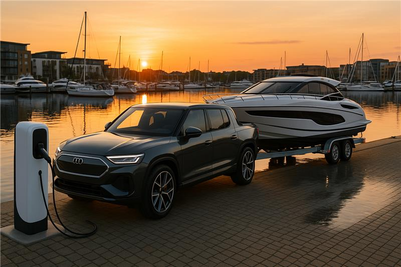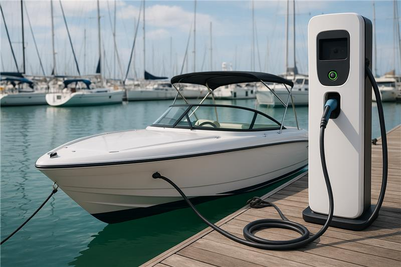EV Vs Hydrogen - Towing a greener line
Published:
Read Time: 8 mins
With a shift away from petrol and diesel, what is likely to power your next 4x4 boat hauler? Ali Khan at Vestel Mobility UK looks at whether electric vehicles (EVS) or hydrogen fuel cell vehicles (FCVS) will be the future.
As the UK moves away from internal combustion engine (ICE) vehicles, a crucial debate has emerged across public and private forums about the future of electric vehicles in the face of developing hydrogen fuel cell technology.
Both technologies offer significant environmental benefits over fossil fuels, but they come with distinct advantages and challenges. This is perhaps the only transition in the history of the motor car that is a factor of external factors (the environment) rather than the simple evolution of the car to its next logical, better, faster, more efficient, more convenient generation. While EVs and HFCVs can offer many of those benefits, which is likely to prevail?
Efficiency and environmental
One of the primary factors in this debate is efficiency. When comparing the two technologies, battery-electric vehicles (BEVs) have an edge. Their overall efficiency, from power generation to forward motion, exceeds 70%, meaning a significant portion of the electricity generated and drawn from the grid is effectively converted into motion. The process of generating that energy in the first place is greener, given that over 40% of the UK’s grid electricity is now generated from renewables, not including those who charge at home with the addition of domestic solar power.
Hydrogen FCVs are far less efficient, with an overall efficiency of around 30–40%. This loss stems from the multi-step process required to produce hydrogen, compress and transport it, and then convert it back into electricity within the vehicle. The extra energy losses at each stage make hydrogen less efficient in terms of simple energy-in vs energy-out.
Beyond efficiency, environmental impact is crucial in determining the best long-term solution. EVs and hydrogen cars emit no greenhouse gases at the point of use, making them far cleaner than traditional petrol or diesel vehicles. However, the production process for each type of energy source tells a different story. EVs are powered by stored electricity, which can increasingly be generated from renewable sources. Yet, their batteries require raw materials like lithium, cobalt, and nickel, whose extraction has significant environmental and ethical concerns.
Ironically, hydrogen’s production remains largely dependent on fossil fuels, with steam methane reforming (SMR) being the dominant method, which itself releases CO2. Depending on the production method and carbon-recapture technology used, creating 1kg of hydrogen will generate 9–12kg of CO2 without carbon capture, but only 2–4kg with carbon capture. That is still far better than burning fossil fuels, though. One kilogram of hydrogen will offer up to 20kWh of usable energy in an FCV, equivalent to the usable energy from about 10 litres of petrol in a typical ICE. Burning that petrol would produce over 20kg of CO2, so hydrogen is still a clear winner over ICE for CO2 emissions.
As for EVs, the maths is more challenging to pin down due to the dynamic nature of renewable vs. fossil fuel energy production. Charge your car using an energy company that only buys energy from renewable sources (i.e. Octopus) or charge at home from domestic solar, and the running CO2 emissions are virtually zero. Charge from the UK’s grid using a typical daily mix of energy sources, and that 20kW will have produced around 6kg of CO2 to generate today. That figure is falling on the strength of renewables in the UK, with clean energy targets for 2030 and net-zero by 2050 tipping the CO2 balance in favour of BEVS, even charging publicly going forward.
Perhaps the defining factor in the CO2 emissions of hydrogen versus electricity will be getting that energy to the end user. The UK is already mapped with a copper grid, albeit needing upgrading in many areas, meaning transporting energy to the point of charging is easy and relatively efficient using HV transmission to reduce cable losses. Moving compressed hydrogen to service stations across the UK will demand a significant road transport system (like shipping petrol and diesel) that will generate significant CO2.
The convenience factor
For the 1.3 million BEV owners and 740,000 PHEVs already driving on UK roads by the end of 2024, the convenience factor cannot be underestimated. A survey by the Electric Vehicle Association England found that 81% of EV owners do most or all of their charging at home or work, meaning a trip to a service station is essentially a thing of the past.
Five hours of charging overnight with a simple 7kW charger would deliver around 35kWh of charge to the vehicle. That would provide a range of 100 miles in an SUV-style EV and nearer 170 miles in small EVs like the Tesla Model 3 or Hyundai Ioniq – both of which could tow a smaller boat (1,00kg and 750kg respectively). For the majority of home-charging BEV and PHEV owners, unlike ICE or potential hydrogen vehicles, they almost always leave the house with a full charge and maximum range and do not have to stop at a service station or public charging point for the vast majority of their journeys.
The icing on the cake for EVs is the UK's growing number of dedicated overnight EV charging electricity tariffs from as little as 8.5p/kWh. That 35kWh / potential 100-170 mile range will cost less than £3 in fuel.
Towing and launching
For those who own powerboats, RIBs, or trailers, EVs and HFCVs offer several major advantages over their ICE counterparts, as both use electricity as key power to drive (stored in EVC, generated in HFCV).
Electric motors deliver instant torque, ideal for pulling heavy boats up steep slipways or manoeuvring trailers into tight marina spaces. Unlike ICE engines that need to rev to find their torque, EVs deliver maximum pulling power from a standstill, smoothing the driving experience and making launches more controlled.
EVs also tend to be heavier due to their battery packs, which sit low in the chassis. This added weight improves traction and stability while towing—a huge benefit when pulling a boat along the motorway or fighting for grip on a green slip. With regenerative braking, EVs also provide enhanced control when slowing down with a heavy load behind, helping to smooth the drive and reduce wear on braking systems.
Many electric 4x4s now have advanced traction management software, precise throttle control, and even dedicated tow or crawl modes. These features allow for superior low-speed control and terrain adaptability, whether dealing with gravel, grass, or a muddy slipway.
Infrastructure…?
Infrastructure will likely be the deciding factor in the race between electric and hydrogen-powered vehicles to replace petrol and diesel. The UK is already well on its way to building a robust public charging network, with over 80,000 public charging points and substantial government investment to expand the network further. Over 1 million home chargers have already been installed in the UK, with many owners waiting for installation.
In contrast, hydrogen refuelling infrastructure remains sparse, with only around a dozen public refuelling stations nationwide – and only 200 in Europe. Building a nationwide hydrogen refuelling network would require massive investment and logistical changes, as hydrogen production, storage, and distribution are far more complex than simply expanding an existing electrical grid.
Shell has recently closed all its hydrogen filling stations in the UK and much of the US, and there are just two hydrogen cars currently available to private buyers in the UK—the Hyundai Nexo and Toyota Mirai. According to the DVLA, only 98 Toyota Mirai and 29 Nexo are registered on UK roads. That is 0.006% of the number of BEVs and PHEVs registered on UK roads today. For boat owners, either would be a limited choice as the Hyundai I has a 1,000kg towing capacity, and the Mirai has zero – it is not designed to tow at all.
Conclusion: The future is electric
Considering all these factors, it becomes clear that electric vehicles are a far more viable option for the future of personal transport in the UK than hydrogen. While hydrogen technology may yet have a role in UK transport, particularly in industrial and heavy-duty applications, it's not a frontrunner technology in the transition to greener transportation generally.
While EVs are not without their challenges, Vestel Mobility, one of Europe's largest EV Charger manufacturers, is working hard on solutions for charging at home and ultra-rapid (up to 1 MWh) solutions for public charging infrastructure, with attached solar power battery storage for remote or off-grid locations.
EV’s superior energy efficiency, expanding infrastructure, and ongoing battery advancements (and recycling tech) positions the technology as a natural successor to ICE vehicles for most users in the UK. Add to that their unique strengths in towing and boat launch scenarios, from high torque and precise control to braking and stability, and it's easy to see why EVs are making waves in the powerboat and trailer-towing world.
Ends
Editors notes
Vestel, part of Zorlu Holdings, is one of Europe's largest electronics and appliance manufacturers, best known for being the OEM partner behind one in every three TVs and display screens sold in Europe. Based in Manisa, Turkey, Vestel City is Europe’s biggest single-site manufacturing complex, where a dedicated EV division has been designing and manufacturing EV charging solutions for household name brands for over five years. Working towards becoming a net-zero emissions company, Vestel is leveraging its manufacturing expertise, economies of scale and European location to reduce the cost and carbon footprint of EV charging solutions.
With a production capacity of over 700,000 EV charging units per year, Vestel makes a broad range of devices, from compact chargers for home use to the largest commercial fast charging stations for enterprise businesses and public infrastructure. Alongside its own brand EV chargers, Vestel will continue to manufacture OEM charging solutions for premium electric vehicle brands, service station networks, and electricity suppliers across Europe, all “Powered by Vestel”.


